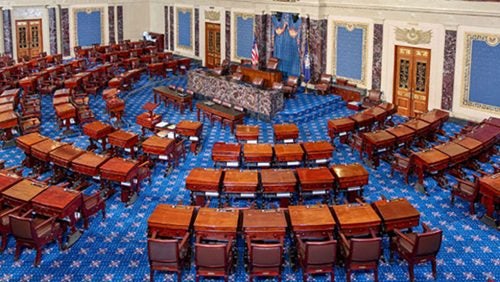What Should you Know About the Filibuster? Professor Caroline Fredrickson, a Senate Veteran, Weighs In
March 31, 2021

Distinguished Visitor from Practice Caroline Fredrickson spent a good part of her career in the Senate — including as deputy chief of staff to then-Senate Democratic leader Tom Daschle — before leading the American Constitution Society for a decade, and then joining the Georgetown Law faculty last year.
For Fredrickson, the current debate over whether to end the Senate filibuster presents an opportunity to take a closer look at the quirky procedure’s past while considering its future. She breaks down some key points to consider in a new video, and answers additional questions about the filibuster — and teaching the evolving topic in real time — in the interview below.
Tell us more about how the filibuster was employed in the civil rights era.
Starting in the late 1950s, senators began to use the filibuster to thwart passage of civil rights legislation intended to address the deeply entrenched racism and racist policies that affected so many areas of American life. Anti-civil rights Dixiecrats were able to obstruct anti-lynching bills; bills prohibiting poll taxes; and bills prohibiting discrimination in employment, housing, and voting.
Most notable were their filibusters of the most significant civil rights bills in United States history –the Civil Rights Acts of 1957 and 1964. Then-Democratic Sen. Strom Thurmond held the floor against the 1957 Act without a break for 24 hours and 18 minutes. Even longer, the filibuster against the Civil Rights Act of 1964 went on for 74 days, although it was ultimately unsuccessful.
When’s the last time we came this close to getting rid of the filibuster altogether?
Despite the filibuster’s shameful track record, the Senate did not reform the filibuster again until 1974 after initially adopting the cloture rule in 1917. By that time, its usage had become more widespread as Senators sought to delay and derail a broader array of proposed bills outside of civil rights protections. Before 1966, there was an average of five filibusters per year. That number grew to 10 between 1971 and 1973, and reached 18 by 1974.
As part of a post-Watergate demand for other reforms, including changes to ethics laws and campaign finance limits, Senators adopted a new cloture rule. While not the straight majority vote favored by some reformers, Democratic Sen. Walter Mondale of Minnesota compromised and joined with Kansas Republican Senator James Pearson to reach a consensus position that decreased the vote for cloture from two-thirds to three-fifths of the body—in other words, from 67 to 60, the current rule for legislation.
The move required a sympathetic vice president (Nelson Rockefeller), and then a majority willing to uphold his ruling. The push took a month, and eventually prevailed by 56-27.
What did former Senator Harry Reid (D-Nev.) do on the filibuster when he was majority leader, why did he pull the trigger, and do you think he had a sense of where it might lead?
Although a cloture motion—the formal process to bring an end to a filibuster—is still necessary for legislation, the Senate did adopt changes to its rules governing nominations to executive branch positions and federal judgeships. In 2013, Democrats altered filibuster rules so that only a simple majority is required to end debate on nominees to lower courts and administration positions. In 2017, Republicans extended that change to Supreme Court nominations.
Some argue that the Democrats’ decision to abolish supermajority requirements to confirm federal lower court judges somehow set in motion the Republicans’ move to apply that same rule to Supreme Court justices and gave President Trump the ability to fill the courts with his picks in an overly speedy manner. In reality, however, it is hard to believe that Mitch McConnell would not have taken the initiative to abolish the supermajority requirement had Trump’s nominees been filibustered.
What has been the most interesting part about teaching law students about the filibuster in your legislation class this spring?
It’s always great to be able to illustrate what you are teaching in class with current events. In this case, just as I was teaching about the legislative process, and in particular about how Congress operates, President Biden and the Democrats were discussing how to move his legislative agenda. The main obstacle they faced was the Senate’s filibuster.
We talked in class about how a filibuster can be overcome and what types of legislation are exempted from the supermajority requirement — and everyday in the news, there was another story about why that is so important to understand.
The pandemic relief bill, governed by budget reconciliation, was not subject to the 60 vote threshold – but the minimum wage increase could not be included in that bill because it could not get past the Byrd Rule. My students understand why that is.